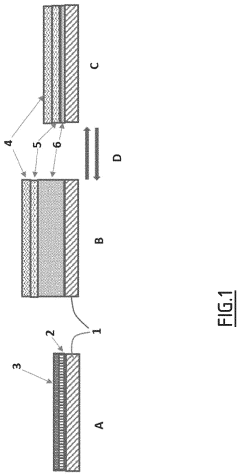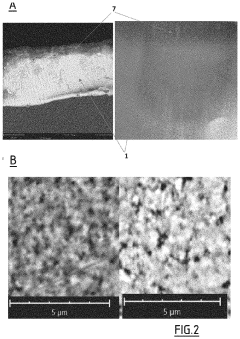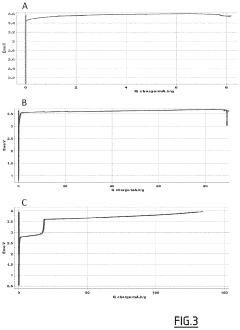Anti-dendrite negative electrodes, and the electrochemical cells containing them
a negative electrode and dendrite technology, applied in the field of energy storage, can solve the problems of reducing electrochemical performance, difficult to obtain the required level density, and inability to use negative electrodes containing metallic lithium during assembly, so as to reduce the nucleation energy of lithium, and limit the volume variations of the negative electrode
- Summary
- Abstract
- Description
- Claims
- Application Information
AI Technical Summary
Benefits of technology
Problems solved by technology
Method used
Image
Examples
example 1
[0104]A Li-free negative electrode was assembled as follows A layer of Zn which has lithiation potential 0.157 V vs metal Li was deposited directly on Cu current collector by electroplating and then, a layer of Bi which has lithiation potential 0.82 V vs metal Li was deposited on top of Zn layer by slurry coating of nanoparticles with size from 30 nm up to 100 nm, preferably 50 nm.
[0105]Its initial structure and its change during cycling is illustrated in FIG. 1.
[0106]In FIG. 1, (A) depicts its initial structure, (B) depicts the structure after the 1st charge and (C) after the discharge, where (B) and (C) are reversibly achieved during the following cycling (D).
[0107]As illustrated in Figure (1A), a representative negative electrode in its initial stage comprises a current collector (1) in the form of a Cu foil, coated with the layer (1) depicted by figure (2)), which can comprise typically Zn. On the top of this layer is further coated the second layer (2) (depicted by figure (3)) ...
example 2
n of 2 Layers Zn / Bi with One Zn Layer and No Addition Layer
[0114]Electrochemical cells were prepared with the negative electrodes with different configurations and compositions of layers (2) and (3) as depicted in FIG. 1 above, with a NMC positive electrode (Nickel Manganese Cobalt oxide), with a sulfide electrolyte and sulfide solid-state electrolyte as separator.
[0115]Cathode composite powder comprises a positive electrode active material (LiNi0.8Mn0.1Co0.1O2), a sulfide-based solid electrolyte, and a conductive material at a mass ratio 70:25:5.
[0116]A press die with ceramic liner and diameter 15 mm was used for electrochemical cells assembling. Initially 70-100 mg of the sulfide-based solid electrolyte powder was evenly spread inside the die and slightly pressed to form a dense pellet. After that, the cathode composite powder was added on one side in an amount corresponding to the required capacity (from 3 up to 4.5 mAh / cm2). A negative electrode disk was added on the opposit...
example 3
Zn / Sn / Bi and 2 Layers Zn+Sn Alloy / Bi
[0122]Negative electrodes were prepared according to two embodiments: either 3 layers (successive layers of Zn, Sn and Bi, respectively, in this order) or 2 layers (successive layers of Zn—Sn alloy and Bi, respectively, in this order) were coated on the current collector. In this case, the alloy layer may be obtained by the standard Eastwood Electroplating Tin-Zinc System.
[0123]The two systems similarly protect the anode from dendrite formation
PUM
 Login to view more
Login to view more Abstract
Description
Claims
Application Information
 Login to view more
Login to view more - R&D Engineer
- R&D Manager
- IP Professional
- Industry Leading Data Capabilities
- Powerful AI technology
- Patent DNA Extraction
Browse by: Latest US Patents, China's latest patents, Technical Efficacy Thesaurus, Application Domain, Technology Topic.
© 2024 PatSnap. All rights reserved.Legal|Privacy policy|Modern Slavery Act Transparency Statement|Sitemap



